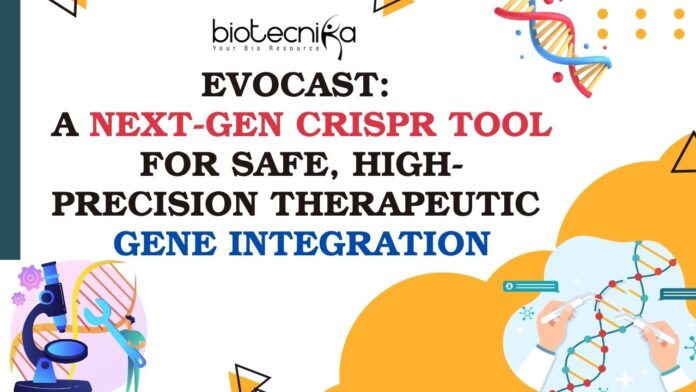evoCAST: A Next-Gen CRISPR Tool for Safe, High-Precision Therapeutic Gene Integration
Imagine standing before a towering skyscraper, and you notice the magnificent structure has one small faulty brick threatening the structure’s integrity. Now, the real challenge is to replace that without even shaking the building, without breaking walls, and without leaving any trace of repair. Sounds like science fiction, right? But with today’s rapidly advancing science and technology, what once seemed impossible is now well within our reach.
Like a hidden faulty brick in a skyscraper, our DNA can carry defective genes that lead to serious diseases. Fixing them has been a significant challenge, especially inserting large, healthy DNA segments at exact spots without causing harm. It’s like having the blueprint but missing the right tools—until now.
Gene therapy is revolutionizing the healthcare sector by aiming to correct defective gene segments that cause disease. One significant way of correcting faulty genes was with the help of CRISPR Technologies, which inserts the correct gene by often breaking open the double-stranded DNA. However, this process can be less effective, as there could be chances of unnecessary cuts and insertions at non-targeted sites.
With the advent of technology, scientists are now capable of avoiding these off-site changes as well. In a recent scientific breakthrough, researchers have developed a system for programmable gene insertion in human cells using a specially evolved version of CRISPR-associated transposase.
This new method makes gene therapy much more efficient as it avoids the unintended changes resulting from CRISPR techniques. With the help of this new technology, scientists have successfully inserted healthy genes into human cells, which is a potential area in revolutionizing gene therapy for various genetic diseases.
What Is a CRISPR-Associated Transposase?
A CRISPR-associated transposase is an enzyme found in bacteria. It helps move large segments of DNA from one place to another. While this process works well in bacterial systems, using it in human cells has been difficult due to low efficiency.
However, researchers at the Broad Institute of MIT, Harvard, and Columbia University have changed that. They successfully modified the enzyme in the laboratory, which showed a hundredfold increase in the efficiency of gene-insertion capacity.
The Role of CRISPR-Associated Transposases (CASTs)
CASTs are natural enzymes found in bacteria that can insert DNA segments into specific genome locations without cutting the DNA strands. This method reduces potential errors and is more precise. However, in their natural form, CASTs have shown minimal activity in human cells.
Developing evoCAST: A Next-Gen CRISPR Tool
Researchers from the Broad Institute and Columbia University have developed an evolved version of CAST, named evoCAST. It was developed through PACE (Phage-Assisted Continuous Evolution). Using this technique, they improved the enzyme’s ability to insert large DNA sequences into human cells. This evolved enzyme showed over 200 times more activity than its natural counterpart.
Researchers started with a natural CAST enzyme from Pseudoalteromonas bacteria. Through hundreds of rounds of evolution, they boosted their ability to insert large DNA sequences into specific locations in human cell genomes.
evoCAST can insert large DNA segments, including entire genes, into specific locations within the human genome. One significant advantage of this system over traditional CRISPR techniques is that the new method avoids cutting DNA strands, reducing the risk of unintended mutations. The efficiency of evoCAST makes it a promising tool for gene therapy applications. This marks a milestone, moving a step closer to the transformation of gene therapy.
Potential Applications in Medicine
- Treating Genetic Diseases
Many genetic diseases result from missing or faulty genes. evoCAST’s ability to insert whole genes could provide a solution by replacing defective genes with healthy ones. This approach could benefit patients with various mutations in the same gene, offering a more universal treatment method.
- Advancements in Immunotherapy
evoCAST could also enhance cancer treatments like CAR-T cell therapy. By precisely inserting genes that help immune cells target cancer, evoCAST may improve the effectiveness and safety of these therapies.
The development of evoCAST represents a significant advancement in gene editing. Its ability to insert large DNA sequences into human cells without cutting DNA strands offers a safer and more efficient method for gene therapy. As research progresses, evoCAST may become a vital tool in treating genetic diseases and improving immunotherapies.
- Using evoCAST, scientists successfully inserted genes related to a few of the most well-known disorders, such as Fanconi anemia, Phenylketonuria, and CAR-T cell immunotherapy.
The evolution of CRISPR-associated transposases like evoCAST marks a new chapter in genome engineering. By allowing programmable gene insertion in human cells at a high level of accuracy, scientists are now closer to making curative therapies for many genetic diseases a reality.
This breakthrough not only demonstrates the power of laboratory evolution but also shows how science can turn a naturally existing bacterial system into a powerful medical tool.























